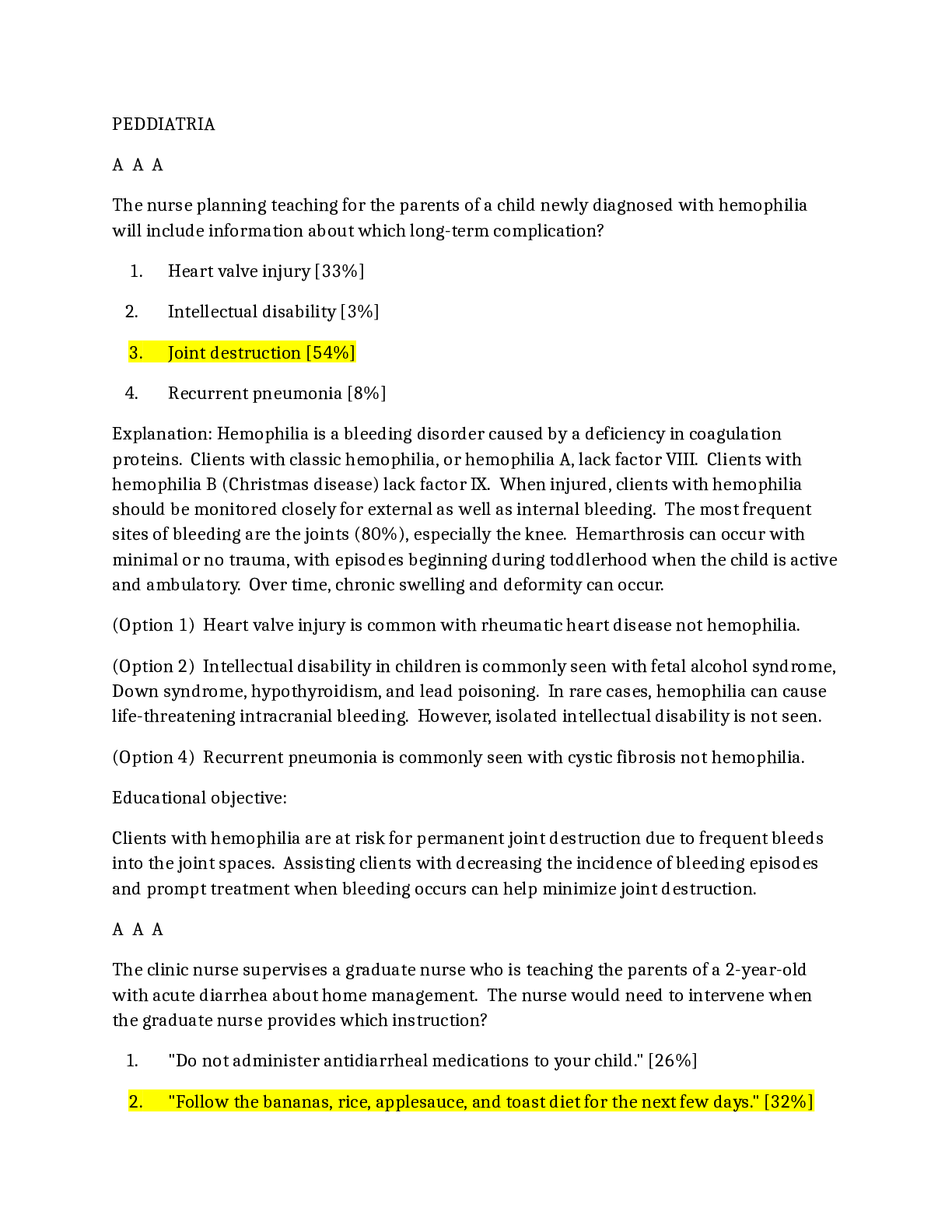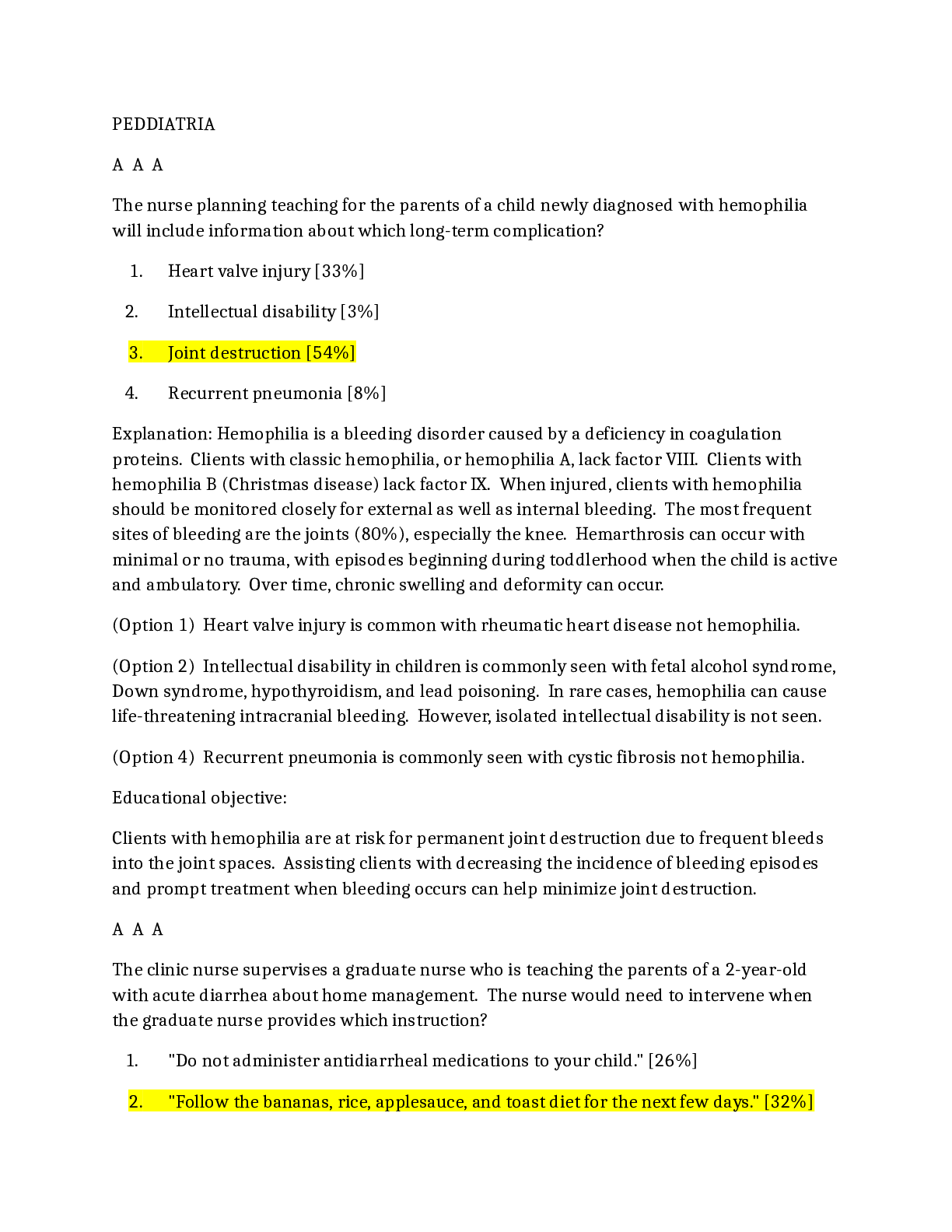A A A
The nurse planning teaching for the parents of a child newly diagnosed with hemophilia
will include information about which long-term complication?
1. Heart valve injury [33%]
2. Intellectual disability [3%]
3. Joint destruction [54%]
4. Recurrent pneumonia [8%]
Explanation: Hemophilia is a bleeding disorder caused by a deficiency in coagulation
proteins. Clients with classic hemophilia, or hemophilia A, lack factor VIII. Clients with
hemophilia B (Christmas disease) lack factor IX. When injured, clients with hemophilia
should be monitored closely for external as well as internal bleeding. The most frequent
sites of bleeding are the joints (80%), especially the knee. Hemarthrosis can occur with
minimal or no trauma, with episodes beginning during toddlerhood when the child is active
and ambulatory. Over time, chronic swelling and deformity can occur.
(Option 1) Heart valve injury is common with rheumatic heart disease not hemophilia.
(Option 2) Intellectual disability in children is commonly seen with fetal alcohol syndrome,
Down syndrome, hypothyroidism, and lead poisoning. In rare cases, hemophilia can cause
life-threatening intracranial bleeding. However, isolated intellectual disability is not seen.
(Option 4) Recurrent pneumonia is commonly seen with cystic fibrosis not hemophilia.
Educational objective:
Clients with hemophilia are at risk for permanent joint destruction due to frequent bleeds
into the joint spaces. Assisting clients with decreasing the incidence of bleeding episodes
and prompt treatment when bleeding occurs can help minimize joint destruction.
A A A
The clinic nurse supervises a graduate nurse who is teaching the parents of a 2-year-old
with acute diarrhea about home management. The nurse would need to intervene when
the graduate nurse provides which instruction?
1. "Do not administer antidiarrheal medications to your child." [26%]
2. "Follow the bananas, rice, applesauce, and toast diet for the next few days." [32%]
3. "Record the number of wet diapers and return to the clinic if you notice a decrease."
[28%]
4. "Use a skin barrier cream such as zinc oxide in the diaper area until diarrhea
subsides." [12%]
Explanation: During bouts of acute diarrhea and dehydration, treatment focuses on
maintaining adequate fluid and electrolyte balance. The first-line treatment is oral
rehydration therapy, using oral rehydration solutions (ORSs) to increase reabsorption of
water and sodium. Even if the diarrhea is accompanied by vomiting, ORS should still be
offered in small amounts at frequent intervals. Continuing the child's normal diet (solid
foods) is encouraged as it shortens the duration and severity of the diarrhea. The BRAT
(bananas, rice, applesauce, and toast) diet is not recommended as it does not provide
sufficient protein or energy.
(Option 1) Use of antidiarrheal medications is discouraged as these have little effect in
controlling diarrhea and may actually be harmful by prolonging some bacterial infections
and causing fatal paralytic ileus in children.
(Option 3) Parents should be taught to monitor their child for signs of dehydration by
checking the amount of fluid intake, number of wet diapers, presence of sunken eyes, and
the condition of the mucous membranes.
(Option 4) Protecting the perineal skin from breakdown during bouts of diarrhea can be
accomplished by using skin barrier creams (eg, petrolatum or zinc oxide).
Educational objective:
When a child is experiencing acute diarrhea, the priority is to monitor for dehydration.
Treatment is accomplished with oral rehydration solutions and early reintroduction of the
child's normal diet (usual foods).
A A A
The mother of a 6-year-old child with cystic fibrosis (CF) has received instruction on the
use of pancreatic enzymes. Which statement made by the mother indicates a need for
further teaching?
1. "I need to monitor the total amount of this medication that I give to my child every
day." [6%]
2. "I should give this medication with or just before my child has a meal or snack."
[10%]
3. "It is okay for my child to chew this medication." [61%]
4. "It is okay to open the capsule and sprinkle the medicine on a tablespoon of
applesauce." [21%]
Explanation: In CF, unusually thick mucus obstructs the pancreatic ducts, preventing
pancreatic enzymes (amylase, trypsin, and lipase) from reaching the small intestine. The
result is malabsorption of carbohydrates, fats, and proteins; the inability to absorb fat�soluble vitamins (A, D, E, and K) is of particular concern. Gastrointestinal signs and
symptoms of CF include flatulence, abdominal cramping, ongoing diarrhea, and/or
steatorrhea.
Nutritional therapy includes the administration pancreatic enzyme supplements with or
just before every meal or snack (Option 2). These enzymes are enteric-coated beads
designed to dissolve only in an alkaline environment similar to that of the small intestine.
They must not be mixed with a substance that would cause them to dissolve prior to
reaching the jejunum. Capsule contents may be sprinkled on applesauce, yogurt, or acidic,
soft, room-temperature foods with pH <4.5. Capsules should be swallowed whole and not
crushed or chewed; chewing the capsules could cause irritation of the oral mucosa.
Excessive intake of pancreatic enzymes can result in fibrosing colonopathy (Option 1).
(Option 4) This is a true statement; some children have difficulty taking a whole capsule.
Capsule contents can be sprinkled in acidic substances such as applesauce. Capsules
should not be taken with milk as they can cause it to curdle.
Educational objective:
Pancreatic enzyme supplements are used to aid the absorption of carbohydrates, fats, and
proteins in a child with CF. They are taken with or just before every meal (not as needed);
should be swallowed whole or sprinkled on an acidic food; and should not be crushed or
chewed. They should not be taken with milk. Excessive intake could result in fibrosing
colonopathy
Read More


